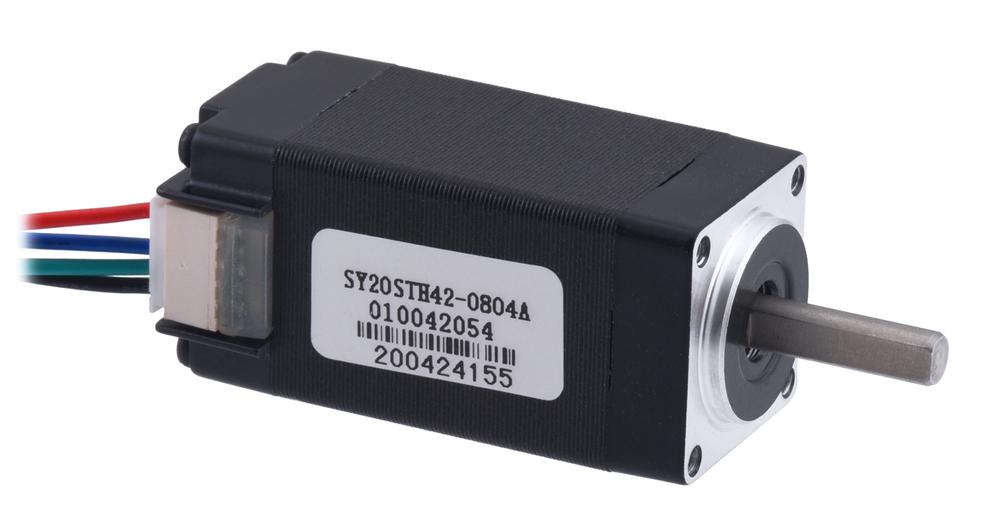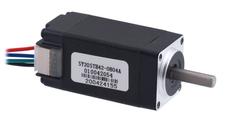Pololu Stepper Motor: Bipolar, 200 Steps/Rev, 20×42mm, 4.3V, 0.8 A/Phase

Description
This compact NEMA 8-size hybrid bipolar stepper motor features a 1.8° step angle (200 steps/revolution) and high precision. Its small size and lightweight design (80 g) make it perfect for projects with limited space. Each phase draws 800 mA at 4.3 V, providing a holding torque of 300 g-cm (4.2 oz-in) for reliable performance. The motor has color-coded wires terminated with bare leads for easy connection to your preferred motor driver or one of our Tic Stepper Motor Controllers. With six different interfaces, Tics provide simple and efficient control options.
This stepper motor is ideal for applications such as printers, CNC machines, 3D printers, laser cutters, pick and place machines, linear actuators, and hard drives, where precision position control is crucial. Our 4 mm universal mounting hub can be used to mount objects on the motor's 4 mm-diameter output shaft, ensuring a secure connection for your project. For a similar but slightly less powerful motor, consider our Stepper Motor: Bipolar, 200 Steps/Rev, 20×30mm, 3.9V, 0.6 A/Phase.
Properties
| Brand | Pololu |
| Model | 2256 |
Delivered in 5 to 14 days
Alternative products
- Pololu Sanyo Miniature Stepper Motor: Bipolar, 200 Steps/Rev, 14×30mm, 6.3V, 0.3 A/Phase € 135,75 View product
- In stock Pololu Sanyo Pancake Stepper Motor: Bipolar, 200 Steps/Rev, 3.5V, 1 A/Phase € 75,70 View product
- Pololu Sanyo Miniature Stepper Motor: Bipolar, 200 Steps/Rev, 14×30mm, 6.3V, 0.3 A/Phase, Double Shaft € 138,25 View product
Customer questions
Customer Reviews
- In stock Pololu 5V, 500mA Step-Down Voltage Regulator D24V5F5 € 7,60 View product
- In stock Pololu Mini Pushbutton Power Switch with Reverse Voltage Protection, LV € 4,40 View product
- Deal In stock -31 % Pololu Breakout for JST SH-Style Connector, 6-Pin Male Side-Entry € 1,75 € 1,20 View product
- In stock Pololu QTR-8A Reflectance Sensor Array € 11,- View product
- In stock Pololu 3.3V Step-Up Voltage Regulator U1V11F3 € 6,80 View product
- In stock Pololu Mini Slide Switch: 3-Pin, SPDT, 0.3A (3-Pack) € 2,45 View product
- In stock Pololu 5V, 1.5A Step-Up/Step-Down Voltage Regulator S13V15F5 € 10,60 View product
- In stock Pololu 400-Point Breadboard with Mounting Holes € 4,40 View product
- In stock Pololu Tic T500 USB Multi-Interface Stepper Motor Controller (Connectors Soldered) € 29,80 View product
- In stock Pololu Ribbon Cable Premium Jumper Wires 10-Color F-F 12" (30 cm) € 4,45 View product
- In stock Pololu 6-Pin Female-Female JST SH-Style Cable 63cm € 5,20 View product
- 25 pieces In stock Pololu 0.1" (2.54mm) Crimp Connector Housing: 1x2-Pin 25-Pack € 2,35 View product
- 25 pieces In stock Pololu Nylon Spacer: 10mm Length, 5mm OD, 3.3mm ID (25-Pack) € 2,60 View product
- In stock Pololu Ball Caster with 1/2″ Plastic Ball € 2,90 View product
- In stock Pololu Stranded Wire: White, 26 AWG, 70 Feet € 9,30 View product










